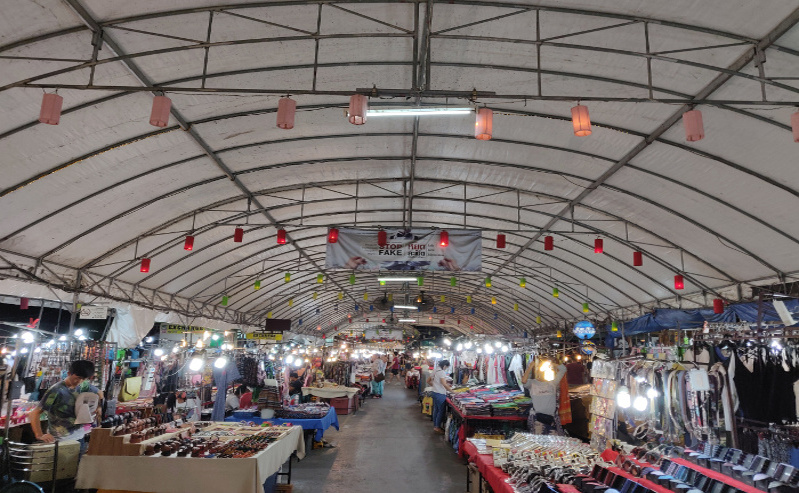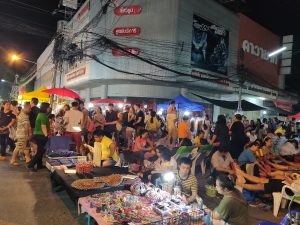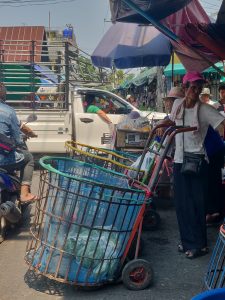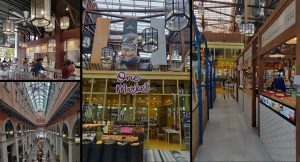
16 Jun Exploring Thailand’s markets
Markets in Thailand offer a bustling cultural experience. With their vibrant, carnival like atmosphere, the markets offer a huge array of goods to browse and in many cases meeting both local and tourist needs with a mix of everyday produce, handmade goods, arts and crafts and street food alongside mass market cheap goods as well as providing a social space.
There were few supermarkets in the local areas and with a market culture, it did appear to be the case that people’s shopping patterns take them to markets rather than supermarkets for a ‘big shop’ (but I wasn’t there long enough for this to be a fact!).
I was lucky enough to visit many of the markets taking place in Chiang Mai in the north of the country including the Saturday and Sunday ‘Walking Streets’ which are on a different scale altogether.
The markets
There are so many, it would be difficult to visit all of them over a week (and still have a holiday) and some were bigger and more interesting than others. The main ones of interest being:
The Walking Streets
These captivating night markets encompass many different spaces and are set-up as large events, more akin to a festival than a traditional market with road closures in place and controlled traffic and people flow. Smoking and drinking are also banned while the roads are cl osed and despite no obvious enforcement this is adhered to. Held every Saturday and Sunday, the Walking Streets start early evening and run through until 11pm.
osed and despite no obvious enforcement this is adhered to. Held every Saturday and Sunday, the Walking Streets start early evening and run through until 11pm.
Saturday was the more authentic of the two, offering pop-up cafes, portrait artists, live music and handmade arts and crafts and clothing. Local temple grounds are transformed into street food markets with seating areas that offer local delicacies and a crew that are continually clearing the areas of rubbish. With less stalls on a Sunday, pop-up massage areas were set-up which were a draw for locals and tourists.
Muang Mai wholesale market
The outdoor, wholesale market has an abundance of products – think of London’s wholesale ma rkets (selling fish, meat and fruit and veg from different sites) all together in one place. There were market porters to move goods around and it was more organised than most of the other markets we visited with fresh fish, meat, flowers, herbs and ready-made curry pastes available.
rkets (selling fish, meat and fruit and veg from different sites) all together in one place. There were market porters to move goods around and it was more organised than most of the other markets we visited with fresh fish, meat, flowers, herbs and ready-made curry pastes available.
Anusam Night Market
This covered night market sprawled across a large area which felt like an aircraft hangar.
Whilst the products for sale were much the same as other markets, it had an array of sit down restaurants and a street food section that wouldn’t look out of place in Brixton Village or Altrincham Market Hall. The market looked to be expanding into further empty spaces, recently adding ‘Chill Square’ with more food and live music.
Ninman One shopping centre and market

An interesting development and perhaps an indication of how shopping centres will change in the UK
and move away from the traditional food court. The centre was approximately a year old and had many food outlets from coffee to Michelin-rated restaurants. At the back was ‘One Market’ where there were a number of street food operators and communal seating areas.
Similar yet different
In many ways (and on the back of the Public Markets Conference looking at global market issues, UK markets are focused on similar issues to those in Chiang Mai, albeit on a smaller scale where we are looking to:
- Serve people in a hygienic, quick way
- Make our markets more sustainable through recycling, reuse and reduced plastic use
- Turn our markets into one-off or regular event spaces (where appropriate) with live music, on street activities and create a social hub
- Connect communities around high streets, town centres and markets
- Open the discussion on smoking at events
- Connect people with food, providing them with access to healthy, affordable food. Perhaps because we aren’t a nation of natural cooks and rely a lot on pre-prepared food we are more wary of a market environment where we perhaps don’t recognise the products or know what to do with them?
Display and purchase
Most of the food sold at the markets was not refrigerated. The explanation was that everything displayed is sold and cooked that day so it’s not a problem. It could also be related to the difficulty of adding infrastructure too but if it works as is for traders and customers, why change it?
Sustainability
Unfortunately, there does appear to be an enormous plastic issue everywhere in Chiang Mai although there were signs that changes were coming in slowly to reduce this. However, we saw little evidence of recycling in terms of market waste, despite many stalls using paper plates, cardboard and plastic water bottles.

On visiting a local market with a cookery school it was good to see the chef bringing along their own food bags and containers instead of plastic bags. The market traders were happy to place their goods in them. London street food operator KERB are currently trialling customers bringing their own containers so we may see this increasing in take-up in the UK.
How have UK markets been inspired?
It would be hard to argue that the concept of food halls and night markets has not been inspired by the markets in South East Asia. Whilst having better weather, there is something about being around lots of people, wandering the streets and eating food cooked in front of you that makes for a good time (for many).
In the last decade, the UK street food scene has exploded. In London, established market operators Mercato Metropolitano opens three new sites this year and KERB are opening their first permanent market in Covent Garden. Outside London, GRUB is well established in Manchester (and Rochdale), the Manchester market hall group runs three sites and there is the Baltic Market in Liverpool. Amongst the newer ones, Doncaster has revived its wool market and Rotherham is one of the newest places to open a food hall. The listing magazine Time Out continues its expanding Food Hall collection with a new opening in New York this week.
Another idea we’ve taken from Asia is the creation of Night Markets (particularly outside London) which offer a different shopping experience, indeed sometimes they are food only. It could be down to the UK weather or the logistics of operating after dark but these seem to be slow to take off but we’re currently talking to local authorities about how night markets could kick start an evening economy by extending or adapting their existing markets or creating new ones.
It was great to see local markets still appearing to be the first source of shopping for people in Chiang Mai and to have the chance to experience so many of them. These captivating marketplaces offer a great platform for the local community to offer their produce and provide a way to help support the local economy.
To find out how more about how we work with street markets to increase footfall, turnover, create job opportunities and establish policy frameworks, get in touch.

